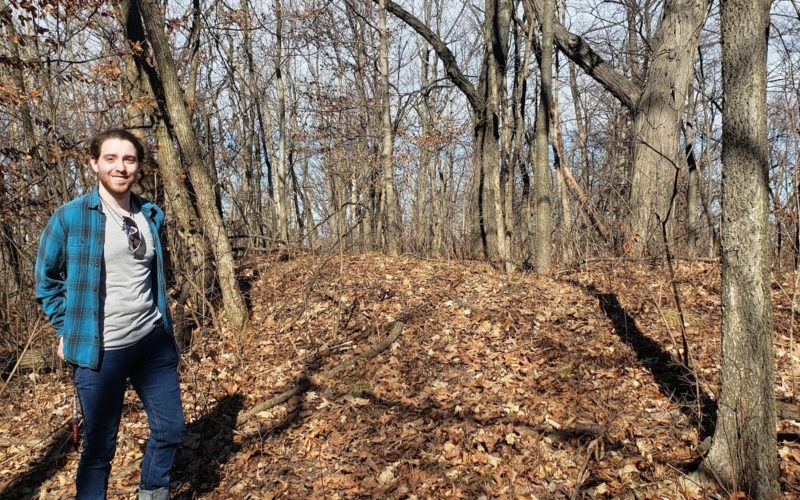S.A.F.E. Club Researching ICC Campus’ Millennium-Old Native American Mound
More than a millennium ago, ancient Native Americans built a sacred mound on the ICC campus overlooking the bluff. Today, the Student Association for the Environment (S.A.F.E.) club is hoping to learn more about it, as well as bring attention to this piece of history and get it governmentally protected.

The mound is on a seldom-walked trail behind the A.I.T. building. However, even if you do walk on the trail, the mound is hidden in plain sight, as it is easy to mistake it for natural terrain.
“We were first made aware of the mound last year,” says Jacob Bohannon, co-president of the S.A.F.E. club.
When the S.A.F.E. club learned about the mound’s existence, they instantly wanted to know more. In order to do this, they enlisted the help of local archeologist and former high school teacher Lynn Carl.
Carl has helped with many excavations and also helped create the Mounds Trail at the nearby Spring Creek Preserve, which is less than two miles north of ICC. It has five burial mounds.

When he visited ICC’s mound, he could tell it was a Native American mound and some details about what kind it is. His current hypothesis is that it is a Woodland burial mound.
“Woodland” refers to the Woodland Native American tribes who were in the region from about 1,000 B.C. to 1,000 A.D.
They were a bunch of tribes that were a group of hunter-gatherers, meaning that they fed themselves through hunting and gathering rather than farming.
Carl believes the mound is Woodland, more specifically middle-to-late Woodland between 600 and 1,000 A.D.
He partially came to this conclusion from the neighboring Spring Creek Preserve mounds. “All of these stretched along here are Woodland and those were the people that buried their people in that type of circular, conical-shaped mound,” says Carl.
However, the ICC mound is not a perfect circle. It is about a 15 by 20 feet.
This opens the other possibility that the mound was built by Mississippian Natives. They replaced the Woodland Natives in about 1,000 A.D. when the ancestors of the Mississippians traveled down from the Great Lakes region.
“It was more of a farming and trading group. They did a lot of craft brewing and trading,” says Carl.
They were in the region from 1,000 A.D. to about 1,500 A.D., whenthey were replaced by the tribes that were around when Europeans arrived in the late 1,600s.
While Mississippians did make burial mounds, they mostly made temple mounds, which are more rectangular and were used to worship indigenous gods.
The ICC mound might be a temple mound, though it would be oddly-shaped if this is the case.
To find out for sure, Carl recommended the S.A.F.E. Club should contact a professional in burial mounds. “You would have to do a study on the site with someone who really knows what they’re doing to say definitively,” says Carl.
The S.A.F.E. club recently made progress on finding someone.
“The ICC Administration has been given the go-ahead to have Prairie Archeology & Research come out to the ICC campus to take a more professional look at the mounds we have on campus,” says Bohannan.
There is no official date yet for the Prairie Archeology and Research visit.
If the mound was indeed made by Native Americans, the S.A.F.E. club will continue the work of the previous S.A.F.E. club student: protecting the mound.
“We were also informed that a previous member of the same club (S.A.F.E.) had been attempting to get them governmentally recognized so that they would have protections offered by that,” says S.A.F.E. Club co-president Jordan Bohannon.

Government protection would help against further looting of the site, as someone has stolen from the site in the past.
This is very common with burial mounds. At the nearby Spring Creek Preserve a couple miles north, there are many Native American mounds, all of their four major mounds have been looted.
“People come up here thinking they can dig up skeletons, split knives, jewelry, or an ax and sell it in the market or something. But all of these have been dug into by people who are looters: grave robbers, basically,” says Carl.
The S.A.F.E. Club wants the ICC site to be designated as a protected area, which would put up a sign that warns anyone thinking of stealing that it is a Class 4 Felony to steal from Native American mounds. There are already some up at the Spring Creek site.
“Burial mounds are very sacred. It’s also a human remains site so it needs to be protected,” says Julia Carpenter, the other co-president of the S.A.F.E. club.

